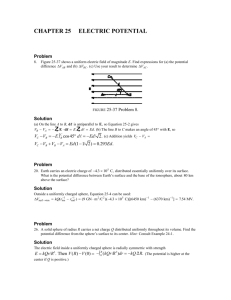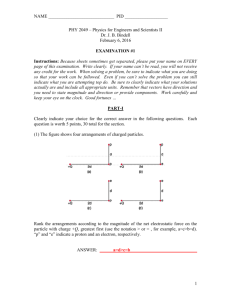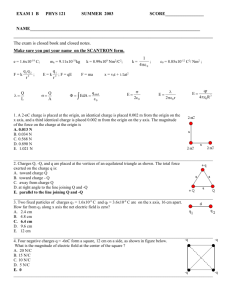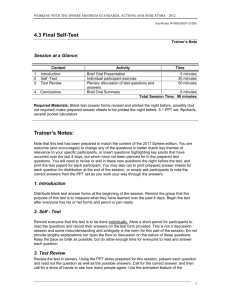2 1. 4 point charges (+1 C, +3 C, -4 C and -5 C
advertisement
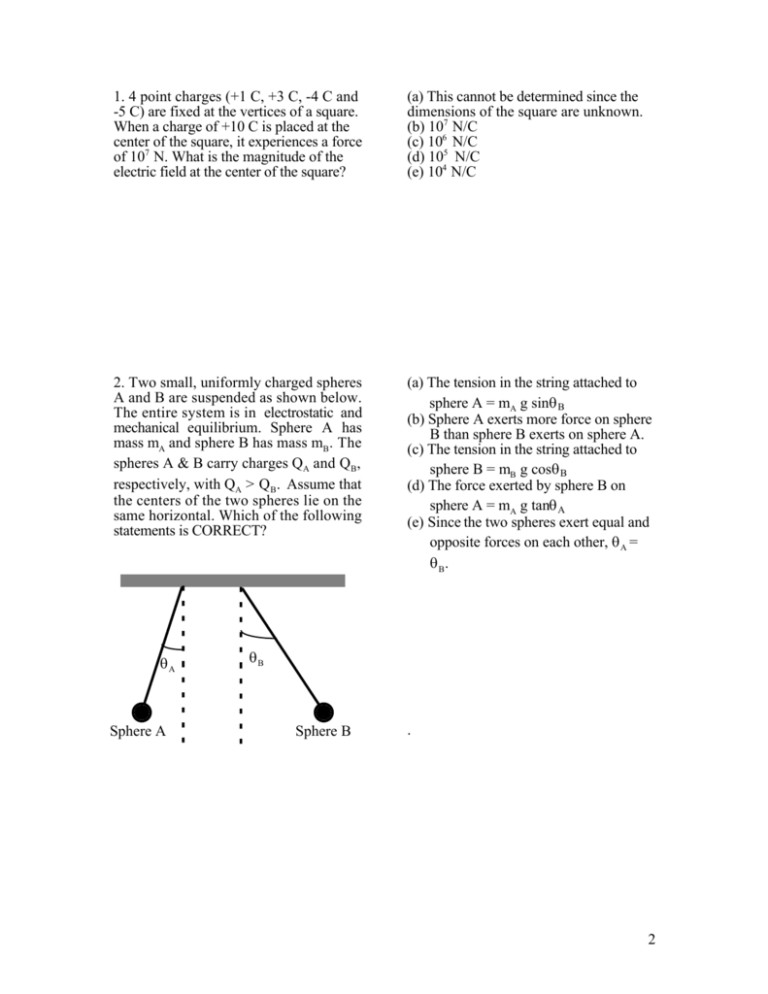
1. 4 point charges (+1 C, +3 C, -4 C and -5 C) are fixed at the vertices of a square. When a charge of +10 C is placed at the center of the square, it experiences a force of 107 N. What is the magnitude of the electric field at the center of the square? (a) This cannot be determined since the dimensions of the square are unknown. (b) 107 N/C (c) 106 N/C (d) 105 N/C (e) 104 N/C 2. Two small, uniformly charged spheres A and B are suspended as shown below. The entire system is in electrostatic and mechanical equilibrium. Sphere A has mass mA and sphere B has mass mB. The spheres A & B carry charges QA and QB, respectively, with QA > Q B. Assume that the centers of the two spheres lie on the same horizontal. Which of the following statements is CORRECT? (a) The tension in the string attached to sphere A = mA g sinθ B (b) Sphere A exerts more force on sphere B than sphere B exerts on sphere A. (c) The tension in the string attached to sphere B = mB g cosθ B (d) The force exerted by sphere B on sphere A = mA g tanθ A (e) Since the two spheres exert equal and opposite forces on each other, θ A = θ B. θA Sphere A θB Sphere B . 2 3. Suppose you place an excess negative charge on a plastic pen by rubbing it on your sweater and then bring the pen close to a thin metal foil on a very dry day. Which of the following statements is correct? Metal Foil PEN 4. The figure below shows two charged particles of charge +9Q and -Q fixed in place at x = 0 and x = L, respectively. At what point (other than infinitely far away) can a proton be placed so that it is in equilibrium? +9Q x=0 (a) Since the metal is an insulator and does not have freely mobile electrons, it will not react to the charged pen. (b) The metal foil will be repelled since the pen will repel electrons from one side of the foil to the other. (c) The metal foil will be attracted by the pen because a positive charge will be induced on the side of the foil closest to the pen. (d) The metal foil will be repelled by the pen because a negative charge will be induced on the side of the foil closest to the pen. (e) The metal foil will be attracted by the pen because a negative charge will be induced on the side of the foil closest to the pen. (a) x = -L/2 (b) x = -10L/2 (c) x = +3L/2 (d) x = +L/2 (e) x = +9L/8 -Q x=L 3 5. Jennifer peels apart two neutral pieces of scotch tape that are stuck together. She finds that (a) they attract each other and (b) the force of attraction increases strongly when the distance between the tapes is reduced. Which of the following fundamental laws of nature is qualitatively illustrated by this simple experiment? (a) The quantization of charge. (b) The conservation of charge. (c) Gauss’ Law. (d) Coulomb’s Law. (e) Both Coulomb’s Law and the conservation of charge. 6. A molecule of water acts like an electric dipole in which the charges are “effectively” separated by a distance of 10-12 m. The magnitude of the electric field at a point located 10-9 m away on the perpendicular bisector of this electric dipole is 106 N/C. What is the magnitude of the electric field at a point located 2 x 10-9 m away on the perpendicular bisector? (a) 4 x 106 N/C (b) 2 x 106 N/C (c) 5 x 105 N/C (d) 2.5 x 105 N/C (e) 1.25 x 10 5 N/C 7. The figure below shows 5 point charges arranged on the perimeter of a circle of radius 10 cm centered at the origin of the x-y co-ordinate system. The +8 C charges are at opposite ends of a diameter, as are the -5C charges. Determine the magnitude & direction of the electric field at the center of the circle. (a) 5.67 x 10 12 N/C, making an angle of -820 with the +x axis. (b) 8.65 x 1012 N/C, making an angle of 320 with the +x axis. (c) 9 x 108 N/C, directed along +y direction (d) 9 x 1012 N/C, directed along -y direction. (e) 9 x 1012 N/C, directed along +y direction y -5C 150 x +8C +8C 150 -5C -10C 4 8. In the figure below, two curved plastic rods, one of charge +2 q and the other of charge + q, form a circle of radius R in an xy plane. The x-axis passes through their connecting points, and the charge is distributed uniformly on both rods. What are the magnitude and direction of the electric field at the center of the circle? y (a) (kq)/( πR2 ), along -y. (b) kq/R2 , along +y. (c) kq/R2 , along -y. (d) (2kq)/(πR2 ), along +y. (e) (2kq)/( πR2 ), along -y. +2q R x +q ` 9. The figure below shows the electric field lines in some region of space. All three lines shown are straight lines. Which one of the following statements is incorrect? A B (a) The force experienced by an electron at B is less than the force it would experience at A. (b) An electron released from rest at B will move with decreasing acceleration towards A. (c) A proton released from rest at A will move with decreasing acceleration towards B. (d) The force experienced by a proton at A is greater than the force it would experience at B. (e) An electron released from rest at B will move towards A with increasing speed. 5 10. A thin plastic ring is uniformly charged with a positive charge as shown in the adjacent figure. Which of the plots below correctly depicts the qualitative variation with of the magnitude of the electric field at a point on the axis of the circle? (In the plots, z varies from 0 to some large distance, with z = 0 at the center of the ring.) z (b) (a) E (c) E z E z z (e) (d) E E z z 6 11. An electron of charge -e and mass m is launched with an initial speed v at an angle of 30 0 to a uniform electric field E as shown below. After how much time does its speed reach its minimum value? v E 30 0 12. In the figure below, a nonconducting rod of length L has charge q uniformly distributed along its length. Also shown is a differential element of length dx along the rod. Which of the following expressions correctly gives the magnitude of the electric field from this element of charge at the point P shown in the figure? P vm 2eE 0.87vm (b) eE vm (c) eE 2vm (d) eE (e) Never, because it constantly accelerates. (a) (a) (b) kq L(x + y 2 ) kqdx 2 L x2 + y 2 kdx (c) L(x2 + y 2 ) kqdx (d) L(x2 + y 2 ) kq (e) 2 x +y2 y dx x 7 13. A spherical balloon made of nonconducting material has a positive charge on its surface. The balloon is now expanded. Which of the following statements is FALSE? (a) The magnitude of the electric field at a point that is inside the balloon before and after expansion does not change. (b) The magnitude of the electric field at a point that is outside the balloon before and after expansion does not change. (c) The magnitude of the electric field at a point on the surface of the balloon does not change. (d) The magnitude of the electric field at a point that was outside the balloon before expansion but is now inside decreases. (e) The magnitude of the electric field at a point that is always inside the balloon is zero. 14. An infinitely long line of charge with a linear charge density λ passes through the axis of a cylinder as shown below. The cylinder has a length L and a radius R. What is the magnitude of the electric flux through the surface of the cylinder? (a) λL/ε0 (b) 2πλRL/ε0 (c) 2πRL/ε0 (d) (2πRL + 2πR2 )/ε0 (e) (2πRL + 2πR2 )λ /ε0 L 8 15. A very large plastic sheet with a uniform positive surface charge density σ on both surfaces is placed parallel to another very large plastic sheet with a negative surface charge density -σ on both surfaces as shown in the edge-on view below. What is the electric field in the region between the two sheets? (a) (b) (c) (d) (e) + + + + + + + + + + + + + + - - - - 16. A net charge Q is distributed uniformly throughout the volume of a sphere of radius R. What is the magnitude of the electric field within the sphere at a distance r < R from the center of the sphere? 2σ pointing to the left ε0 σ pointing to the right ε0 Zero σ pointing to the left ε0 2σ pointing to the right. ε0 Qr 4πε 0 R2 Q (b) 4πε 0r 2 Q (c) 4πε 0 R2 Qr (d) 4πε 0 R3 (a) Qr 3 (e) 4πε 0 R3 9 17. The figure below shows a point charge +Q located at the center of a spherical conducting shell of inner radius A and outer radius B. The distance r is measured from the center of the sphere. Which of the following statements is FALSE? +Q (a) The total charge on the outside surface of the shell = +Q. (b) The total charge on the inside surface of the shell = -Q. (c) The electric field in the region A < r < B is zero. (d) The electric flux through the shell does not change if the position of the charge is changed. (e) The electric field outside the shell (r > B) changes if the position of the charge is changed. A B 18. A thin plastic rod with a negative uniform charge -Q is shaped like a circle of radius R. How much work would you need to do to bring a negative charge -q from infinity to the center of the circle? (a) Zero since the electric field at the center is zero. kQq (b) − R kQ (c) − R kQq (d) + R kQ (e) + R 10 19. The figure below shows 3 equipotentials shaped like concentric ellipses: the center ellipse is at 0V, the middle one at +100 V and the outer one at +200 V. The points A, B and C lie on the outer, middle and inner ellipses, respectively, and form a straight line that is perpendicular to the equipotentials. Which of the following statements is correct? A (a) An electron released from rest at point B will reach point A with a kinetic energy of 1.6 x 10-17 J. (b) A proton released from rest at point A will reach point C with zero kinetic energy. (c) You would need to do to 3.2 x 10-17 J of work to move an electron from point C to point A. (d) The electric field at C points towards B. (e) The electric field at B points towards A. B C 0V +100 V +200 V 20. A solid spherical conductor is given a net non-zero charge. Which of the following statements is correct? (a) The electrostatic potential is largest at the center. (b) The electrostatic potential is largest at the surface. (c) The electrostatic potential is largest somewhere in between the center and the surface. (d) The electrostatic potential is constant throughout the volume of the sphere. (e) We cannot say anything about the electrostatic potential without more details. 11 Answer Key to Sample Exam 1 1. 2. 3. 4. 5. 6. 7. 8. 9. 10. 11. 12. 13. 14. 15. 16. 17. c d c c e e d e b d b d c a e d e (Remaining questions on potential do not apply to Mid Term1 in Sp. 99)


